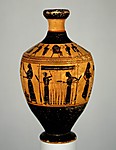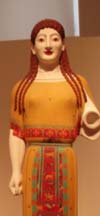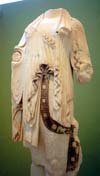Chapter8 |
Images |
Textile Production in ancient Greece
Clicking on the thumbnail will open a new browser window.
 |
There is a lot of preparation that goes into preparing wool to be made into fabric. First, the wool must be gathered from the sheep, then it must be cleaned and carded to remove all the dirt and debris, and finally it must be dyed various colors. Here is video of a Navajo weaver demonstrating carding and spinning. Greek women sometimes used a protective covering over their thigh, called an epinetron (pictured at left), to help in rolling and straightening wool. |
 |
Here a wool basket sits on the floor between two women working the wool. |
 |
In the right side of this picture, one woman pulls the wool out of a wool basket while the other holds a distaff in her left and a spindle in her right to help her spin the wool into thread. The women on the left are folding a finished textile. The distaff acts like a third arm holding the straightened wool. The distaff is an ideal portable way of taking one's spinning to wherever one needed to be. |
 |
These spindle whorls were attached to a spindle (a rod) and allows the spindle to spin like a top and thereby twist the strands of wool into thread. |
| In this video, you can see a Romanian woman using a spindle whorl (below) pulling and attenuating the fluffy gobs of wool from her distaff (above) into thread. Once she has enough thread, she winds it around the spindle (the straight shaft portion of the spindle whorl) | |
| This video from Peru underscores the communal nature of spinning. Women can spin while gathering to talk, swap stories, watch young children (and chickens). All it takes is a spindle and a basket of wool or a distaff. | |
 |
Unlike many western looms, the loom used in ancient Greece was a vertical, warp-weighted loom. In this image, you can see the women working at this upright loom. The woman on the right is prepared to send the shuttle through the warp while the one on the left pushes the weft tightly to the top. The warp is the set of vertical threads held in tension by the loom weights. WThe weft is the thread that passes over and under the warp threads. |
 |
Good evidence for weaving comes from loom weights. These small, pyramidal-shaped clay weights held the warp tight and stabilized the vertical loom used in ancient Greece. The evidence from loom weights suggests that weaving took place in an enclosed or semi-enclosed room with a good source of light, often near an open court. Why do you think these rooms were preferred?* |
 |
Women weavers were justifably proud of the intricate patterns that they created. This vase fragment shows some of the patterns that adorned women's clothing, including horsemen riding their steeds. |
 |
Here are two reconstructions of the Peplos Kore as it might have looked when the original paint on the marble sculpture was still fresh. Such sculptures help us recognize the artistry of Greek women weavers. |
 |
Finally, here is an archaic kore whose beautiful painted meander pattern is still visible on the hem of her dress. |
For more information about the lekythos, visit A Picture of Women weaving and the Metropolitan Museum of Art. To learn more about the two basic garments worn by Greek women, the peplos and the chiton, visit Barbara McManus' page on clothing.
Photo credits:
Epinetron. Terracotta (Black Figure). 500-480 BCE. British Museum 1814,0704.1205.
A stand for a nuptial basin, late 6th century B.C. Athenian Agora. P 7897.
Lekythos. Attic. Attributed to the Amasis Painter. Terracotta (Black Figure). Height: 6 ¾ inches (17.15 cm). Ca. 550-530 B.C. Metropolitan Museum of Art (31.11.10).
Spindle whorls, 6th and early 5th centuries B. C. Athenian Agora, from left to right: MC 948, MC 373, MC 365, MC 938.
Loom weights. Athenian Agora. MC 867.
Red figure calyx krater fragment. Women's work: patterned garment, 470-460 B.C. Athenian Agora. P 9757.
Reconstruction of the polychrome decoration of the Peplos Kore, 530/20 BC, under the features of the Artémis (L) and Athena (R). Study: Vinzenz Brinkmann. Restoration: Alfons Neubauer, Christoph Bergmann. Gilding: Sylvia Kellner. Painting: Ulrike Koch-Brinkmann. Original: Acropolis of Athens (Inv. n°679). Copy painted: Staatliche Antikensammlungen und Glyptothek, Munich. "Bunte Götter" exhibition in the version shown in Athens.
Ionian kore. c. 510-500 B.C. Acropolis Museum 594.